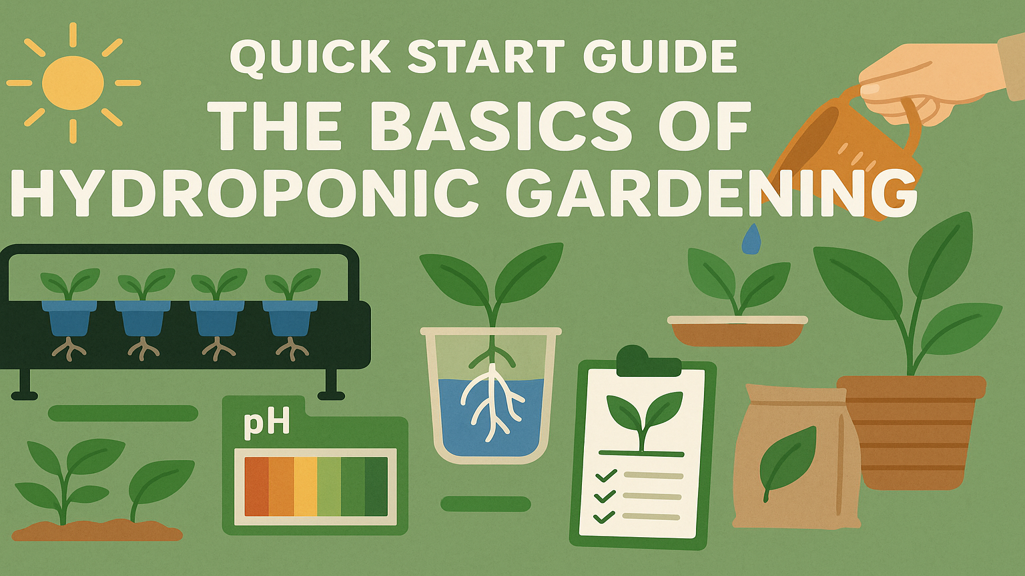Hydroponic gardening is revolutionizing how we grow food—especially in urban environments and climates, where space and soil quality can be limiting factors. By eliminating soil and delivering nutrients directly to plant roots through water, hydroponic systems offer a cleaner, faster, and more space-efficient way to cultivate fresh produce year-round.
Whether you’re completely new or refining an indoor setup, you have the chance to explore the basics of hydroponic gardening. This article breaks down complex systems into practical solutions and supports you with honest, grower-tested advice.

Rooted in Water: What Is Hydroponic Gardening?
The basics of hydroponic gardening is the art of growing plants without soil. Instead, roots are suspended in a nutrient-rich water solution or supported by inert mediums like perlite or coconut coir. This method allows for precise control over nutrient delivery, oxygen levels, and hydration, leading to faster growth and higher yields compared to traditional soil gardening.
The absence of soil reduces the risk of pests and diseases, making hydroponic gardening a cleaner alternative. Moreover, hydroponic systems can be set up indoors or in greenhouses, providing the flexibility to grow crops regardless of external weather conditions.
For a closer look at practical systems, refer to these DIY plans to build your own hydroponic setup at home.
The Science Behind Soilless Success
Hydroponic systems rely on a balanced nutrient solution that provides all essential macro- and micronutrients directly to the plant roots. Maintaining the correct pH level, typically between 5.5 and 6.5, ensures optimal nutrient absorption. Oxygenation is also crucial; roots require oxygen to absorb nutrients effectively, which is often supplied through air pumps or by exposing part of the root system to air.
Several hydroponic techniques cater to different needs and levels of expertise. For instance, the Deep-Water Culture (DWC) method involves suspending plant roots in oxygenated nutrient solutions, promoting rapid growth. Another approach, the Nutrient Film Technique (NFT), allows a thin film of nutrient solution to flow over the roots, providing a continuous supply of nutrients and oxygen.
Building Your First Hydroponic Garden
Starting a hydroponic garden doesn’t require a significant investment or advanced technical skills. Begin with a simple system like the wick or water culture setup, which are ideal for beginners. These systems use basic materials such as containers, wicks, and air pumps to deliver nutrients to plants.
When selecting plants, opt for fast-growing, low-maintenance varieties like lettuce, spinach, or herbs such as basil and mint. These plants thrive in hydroponic systems and provide quick yields, keeping motivation high for new gardeners.
For those ready to scale up or fine-tune their operations, explore efficient hydroponic setups today.
Lighting and Environmental Control
Light is a critical factor in hydroponic gardening. In indoor setups, providing adequate artificial lighting ensures plants receive the energy needed for photosynthesis. LED grow lights are energy-efficient options that can be adjusted to emit specific light spectra suitable for different plant growth stages.
Maintaining optimal temperature and humidity levels is also vital. Most plants prefer temperatures between 65°F and 75°F (18°C to 24°C) and humidity levels around 50–70%. Using fans, heaters, or humidifiers can help regulate these conditions within the growing area.
Nutrient Management and System Maintenance
Regular monitoring of nutrient concentrations and pH levels is essential to prevent deficiencies or toxicities. Using a digital pH meter and electrical conductivity (EC) meter helps maintain the nutrient solution within optimal ranges.
Cleaning and sterilizing the system components periodically prevents the buildup of algae and pathogens. Replacing the nutrient solution every two to three weeks ensures a consistent supply of essential elements for the plants.
Final Thoughts
Hydroponic gardening offers an innovative and efficient approach to cultivating plants, especially in areas with limited space or poor soil quality. By understanding the basics of hydroponic gardening and starting with simple systems, anyone can embark on a rewarding journey of soilless gardening.
With the right tools and guidance, the basics of hydroponic gardening become far more approachable—and that’s exactly where growers shine. Growers who’ve been there replace guesswork with clarity, turning hydroponic curiosity into long-term success.